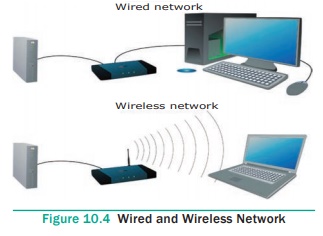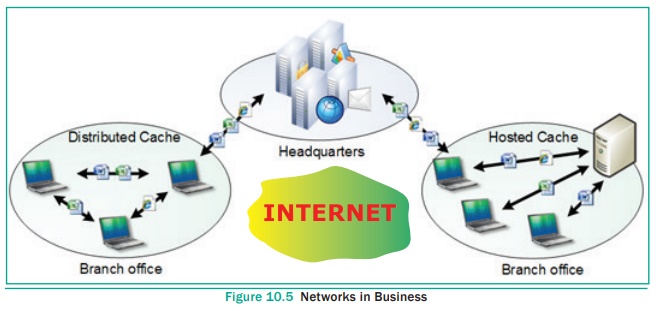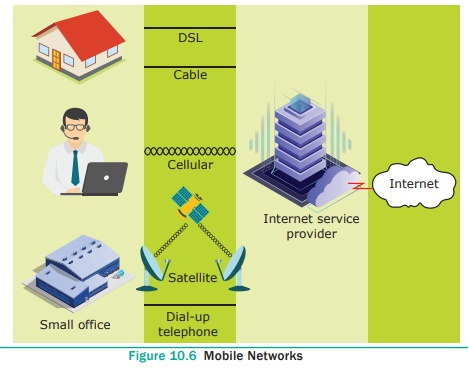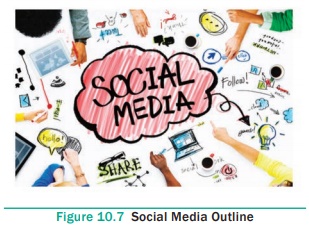Chapter: 12th Computer Applications : Chapter 10 : Introduction to Computer Networks
Uses of the Computer Networks
Uses of
the Computer Networks
The computer networks play a major role in
providing information to large , small organization as well as common man. Now
a days almost all the companies, bank and stores have implemented the
computerized transactions. It may be in same campus, building, city, or at
different places (or) cities. For all these purpose the computer networks are
used.
The common uses of computer network are
● Communication
● Resource sharing
● Data (or) software sharing
● Money saving
Communication
Using computer networks, we can interact with the
different people with each other all over the world. It provides a powerful
communication among widely separated employees, team, section. They can easily
communicate at very low cost via mobile, social media, telephone, e -mail,
chatting, video telephone, video conferencing, SMS, MMS, groupware etc…
Resource sharing
Resource sharing means when one device is accessed
by many systems. It allows all kind of programs, equipment’s and available data
to be accessed by anyone via network irrespective of the physical location of
the resource. Simply resource sharing is sharing such as printers, scanner,
PDA, fax machine, and modems. For example, many computers can access one
printer if it is in network.
Software (or) Data sharing
Using computer network, any application or other
software can be stored at a central computer or server. The software can be
shared among other computers of the network. It provides high reliability and
backup can also be stored at one location for easy availability in case of
crash.
Money saving
Computer networking is also money saving as it
reduces paper work, manpower, resources sharing, software sharing and also time
saving.
Networks in Business
In twenty first century, communication is very
important factor for successful business operations. There by with the growth
of computer network and speedy Internet services, business also developed
drastically.
With the development of cloud computing, global
access and security issues were restricted. Internet conversation made
conversation faster, quick decision making and money saving e-banking paved way
for easy transactions. Business large or small scale B2C, B2B, B2G,C2B, C2C,
C2G, G2B,G2C, G2G or commercial that transfer information across the Internet
can be done. Cheap marketing and easy selection of products through Internet
with customers satisfaction can also be done. Company renewals, license, other
certificates, bill payments, receipts, invoice, stock maintenance, can be done
without any geographical boundaries via Internet and computer networks.
Government subsidies were available for their business to promote their
business by digitization.
Direct human interactions are reduced because of
Internet. Buyer directly purchases any product from manufacturer with less
cost, middle person brokerage charges are reduced. The network connectivity in
business is shown in Figure 10.5
Networks at Home
Now a day, network has become common as it
facilitates communication among devices with in the close vicinity of a home.
Devices in this network can be smart devices, mobile computers, network
printers which are capable of interacting and thereby increase the quality of
life inside home in a variety of ways like automation of repetitive tasks,
increased personal productivity, enhanced home security and easier access to
entertainment. Networks at home were connected in two ways they are:
● Wired
network
● Wireless
network
A Wired
network system is connected with a network cable . For example speakers, CCTV,
printers, outdoors, and scanners etc., with cables.
A Wireless network is connecting devices like
tablets(tab), indoor cameras and E-readers, etc., without cables (WiFi).

Network at home helps us to perform e-banking,
e-learning, e-governance, e-health, telemedicine, call centers, video
conferencing, digitalization of memories, etc. Refer Figure 10.4
Mobile Networks
Mobile network is the network connecting devices
without cable (wireless). Mobile computers, such as laptop, tablet, and hand
held computers, were fastest growing segments. At land areas network was
distributed as cells, each will be served by single – location transceiver, but
generally three cell sites or a base transceiver station. This base station
provides the cell with network coverage and other features that can be utilized
for transmission of voice, data and other content as well. Joining together all
radio coverage is called as wide geographical area. This portable transceivers
used to communicate with one another with fixed transceivers and moving via
more than one cell during transmission. For example mobiles, tablets, pagers,
laptops, engaged with mobile broadband just like modems etc. Refer Figure 10.6
Features of Mobile Networks
● Less consumption of power is used by mobile
devices compared to a single transmitter or satellite since the cell towers are
closer.
● Huge
capacity than a large transmitter, at single frequency can be used for
different or many links as long as they are in different in cells.
● As
mobile phones are now heavily used for data communication, the mobile network
traffic is fully busy.
Mobile phone converts voice, text, multi-media
message or data calls into Radio-frequencies (RF). Mobile phone base stations
transmit and receive these RF signals and connects callers to other phones and
other network.
Private cellular networks can be used at various
locations like research, large organizations and small industries.

After the reach of mobile and access to Internet
work progress faster. People can be in touch with others even while traveling.
Important informations can be received any time without much problems.
Searching important topics, checking mail, watching progress of company can be
done easily sitting at one place. Adequate computer knowledge is sufficient to
access Internet via mobile network.

Social Application
To get connected to with people around the world
through social network media, applications like Whatsapp, Facebook, Twitter,
Blogs, Pinterest, Classmate and so on are in full fledge use.
Through the social media we share our thoughts,
ideas, files and also chats. Refer Figure 10.7 given below.

These social networks share several attributes in
common:
● Membership. Social nets generally requires
user to register names and accounts to avoid duplicate and maintain secrecy. So
many public networks
offer free registration and some meagre charges for their services. Private
networks (such as BANK ACCOUNT HOLDERS groups) restrict registration to people
who meet certain eligibility criteria.
● Content
contribution. These networks allow members to easily
share comments, movies, music, short films and/or photos with others.
● Frequent
return visits. Healthy social net have a group of
members who check in regularly to contribute their share and also for new
updates
● Human relationship building. The common
goal of most social networks is to allow interaction among people, which create
stronger connection with people of different communities.
Benefits of Social Networks
Besides being a fun place to meet and relax with people, social networking leads to some extremely useful benefits to individuals and communities:
● Group information sharing over long distances. Although
friends and family members can keep in contact via mobile phone calls or by text
messages, social nets provide a much richer environment for staying connected.
We can also share photo albums, videos and convey daily wishes through the
social network. Group discussions and Group chats go on in various groups
through which people are kept in touch with each other.
● Broadcast announcements. Quick, easy
way to spread informations of emergencies and natural calamities. Venues and
local shops can advertise upcoming events on social networks.
Business people can market their products through
these networks.
● Fostering
diversity of thought. Some critics of social
networks say that online communities attract people by similar interests and
backgrounds. Indeed, when the people with different opinions do get together on
online, many discussions seem to degenerate into personal attacks and so-called
“flame wars.” The arguments goes
online, healthy debate takes place and some of them become viral also.
Such arguments and talks bring out a relaxation for
busy people from their regular work schedules. It also enriches with current
affairs and keep in touch with people.
Related Topics